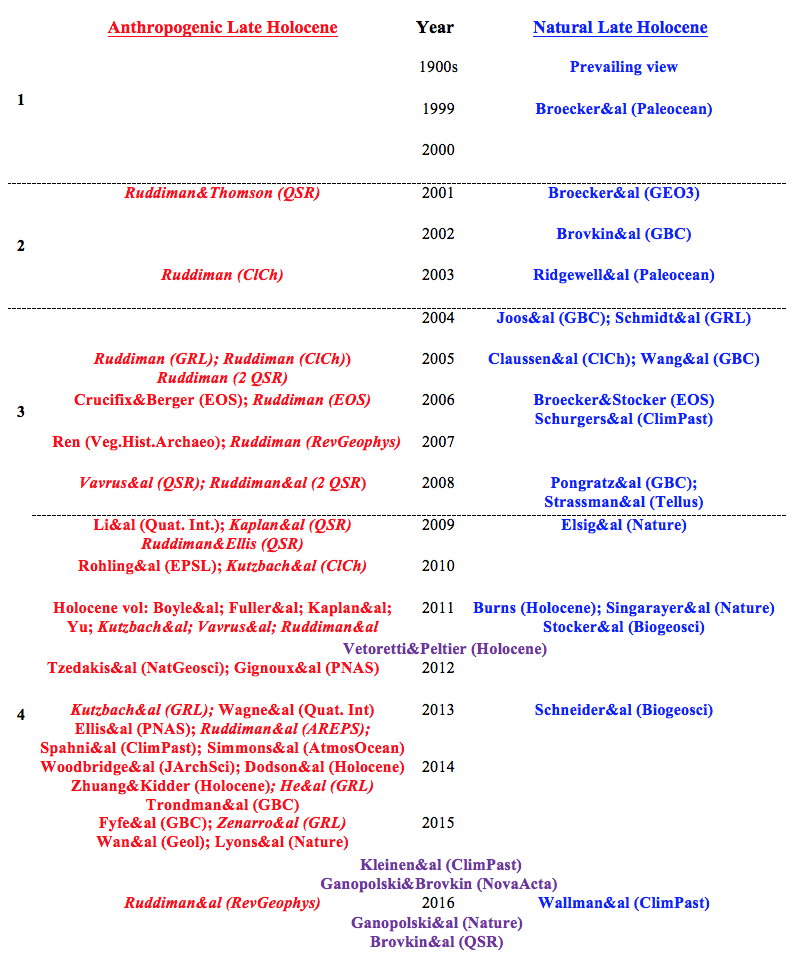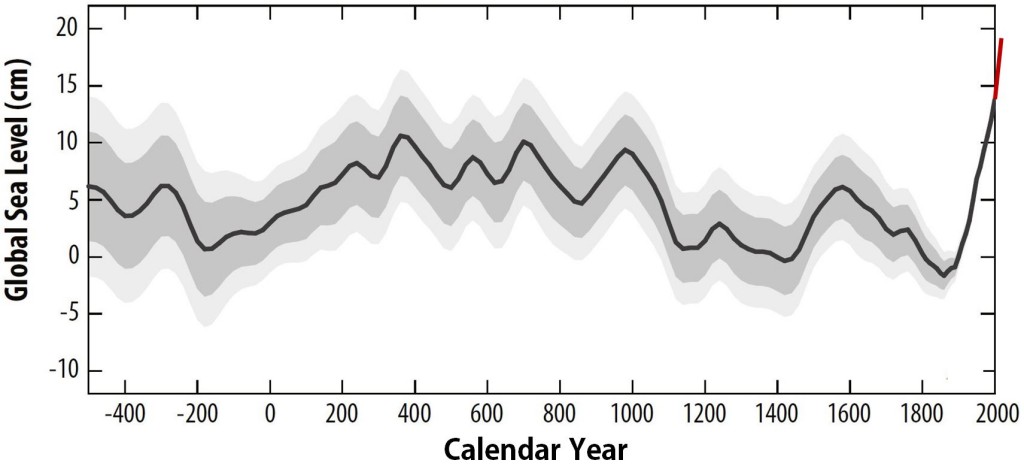Anyone reading pundits and politicians pontificating profusely about climate or environmental science will, at some point, have come across the “volcano gambit”. During the discussion they will make a claim that volcanoes (or even a single volcano) produce many times more pollutant emissions than human activities. Often the factor is extremely precise to help give an illusion of science-iness and, remarkably, almost any pollutant can be referenced. This “volcano gambit” is an infallible sign that indicates the author is clueless about climate science, but few are aware of its long and interesting history…
Climate Science
Unforced Variations: Apr 2016
What drives uncertainties in adapting to sea-level rise?
Guest article by Sally Brown, University of Southampton
Let me get this off my chest – I sometimes get frustrated at climate scientists as they love to talk about uncertainties! To be sure, their work thrives on it. I’m someone who researches the projected impacts and adaptation to sea-level rise and gets passed ‘uncertain’ climate data projections to add to other ‘uncertain’ data projections in my impact modellers work bag. But climate scientists do a good job. Without exploring uncertainties, science loses robustness, but uncertainties in combination can become unbounded and unhelpful to end users.
Let’s take an adaptation to sea-level rise as an example: With increasing scientific knowledge, acceptance and mechanisms that would allow adaptation to potentially occur, one would think that adaptation would be straight forward to implement. Not so. Instead of hard and fast numbers, policy makers are faced with wide ranges of uncertainties from different sources, making decision making challenging. So what uncertainties are there in the drivers of change, and can understanding these uncertainties enable better decisions for adaptation?
Prior to considering adaptation in global or regional models, or implementation at local level, drivers of change and their impacts (and thus uncertainties) require analysis – here are a few examples. [Read more…] about What drives uncertainties in adapting to sea-level rise?
The Early Anthropocene Hypothesis: An Update
Guest post from Bill Ruddiman, University of Virginia
For over a decade, paleoclimate scientists have argued whether the warmth of the last several thousand years was natural or anthropogenic. This brief comment updates that debate, also discussed earlier at RC: Debate over the Early Anthropogenic Hypothesis (2005) and An Emerging View on Early Land Use (2011). The graph below outlines the evolution of that debate through 4 phases.

In phase 1 (the 1900’s), scientists viewed Holocene climate change as driven only by natural causes until the industrial era began. But by the late 1990’s, ice core data revealed late Holocene GHG rises unlike trends in previous interglaciations. Two hypotheses proposed natural causes for the CO2 increase: carbonate compensation (Broecker et al., 1999, 2001) and coral-reef construction (Ridgewell et al., 2003).
In phase 2 (2001-2003), the early anthropogenic hypothesis (EAH) challenged natural explanations for the anomalous late Holocene CO2 (and CH4) rises, attributing them to the spread of early agriculture thousands of years ago.
In phase 3 (2004-2008), several arguments were advanced against the EAH:
* too few people lived millennia ago to have had a significant influence on land clearance, GHG emissions and climate;
* a (proposed) interglacial stage 11 analog for the Holocene suggested that thousands of years of natural warmth still remain in the current interglaciation;
* the weak decrease in ice core δ13CO2 during the last 7000 years did not permit extensive deforestation which would have released abundant 12C -rich carbon.
Papers by myself, my co-authors at Wisconsin, and others during phase 3 rebutted some of these criticisms, but community opinion remained divided.
Phase 4 (2009-2016) has seen a major shift in viewpoint of published papers: 30 papers favor aspects of the EAH, 6 papers oppose it, and 5 are in the middle. Most of the phase 4 papers that oppose the hypothesis or are ‘in the middle’ are based on modeling studies. Many of the 30 supporting papers are broad-scale compilations of archaeological and paleoecological evidence:
* The average GHG trends from 7 previous interglaciations show CO2 and CH4 decreases, in contrast to the late Holocene increases;
* Interglacial stage 19, the closest Holocene analog, shows decreases in CH4 and CO2, and the CO2 decrease closely matches the 2003 EAH prediction;
* CH4 emissions from Asian rice paddies account for 70% of the observed CH4 rise from 5000 to 1000 years ago
* historical data show that early per-capita land use was at least 4 times larger than assumed in several phase-3 land use simulations
* a recent land use simulation based on historical evidence accounts for more than half the CO2 anomaly originally proposed in the EAH;
* pollen evidence shows nearly complete deforestation in north-central Europe before the industrial era began;
* δD and δ18O trends show anomalous late Holocene warmth compared to cooling trends in prior interglaciations, in agreement with A-OGCM simulations of the warming effect of the anthropogenic CO2 and CH4 trends.
_____________
Anyone seeking more detail on this issue should contact pisgahill@gmail.com for pdf copies of the recent 2016 Ruddiman et al. paper in Reviews of Geophysics and an invited paper just submitted to Oxford University Press that summarizes the history of this debate, with full references to the papers shown in the table.
Unforced Variations: Mar 2016
Millennia of sea-level change
How has global sea level changed in the past millennia? And how will it change in this century and in the coming millennia? What part do humans play? Several new papers provide new insights.
2500 years of past sea level variations
This week, a paper will appear in the Proceedings of the National Academy of Sciences (PNAS) with the first global statistical analysis of numerous individual studies of the history of sea level over the last 2500 years (Kopp et al. 2016 – I am one of the authors). Such data on past sea level changes before the start of tide gauge measurements can be obtained from drill cores in coastal sediments. By now there are enough local data curves from different parts of the world to create a global sea level curve.
Let’s right away look at the main result. The new global sea level history looks like this:

Fig. 1 Reconstruction of the global sea-level evolution based on proxy data from different parts of the world. The red line at the end (not included in the paper) illustrates the further global increase since 2000 by 5-6 cm from satellite data. [Read more…] about Millennia of sea-level change
References
- R.E. Kopp, A.C. Kemp, K. Bittermann, B.P. Horton, J.P. Donnelly, W.R. Gehrels, C.C. Hay, J.X. Mitrovica, E.D. Morrow, and S. Rahmstorf, "Temperature-driven global sea-level variability in the Common Era", Proceedings of the National Academy of Sciences, vol. 113, 2016. http://dx.doi.org/10.1073/pnas.1517056113
What is the best description of the greenhouse effect?
What exactly is the greenhouse effect? And what does it look like if we view it from a new angle? Of course, we know the answer, and Raymond Pierrehumbert has written an excellent paper about it (Infrared radiation and planetary temperature). Computer code used in climate models contain all the details.
[Read more…] about What is the best description of the greenhouse effect?
Marvel et al (2015) Part III: Response to Nic Lewis
The first post in this series gave the basic summary of Marvel et al (2015) (henceforth MEA15) and why I think it is an important paper. The second discussed some of the risible immediate media coverage. But there has also been an ‘appraisal’ of the paper by Nic Lewis that has appeared in no fewer than three other climate blogs (you can guess which). This is a response to the more interesting of his points.
[Read more…] about Marvel et al (2015) Part III: Response to Nic Lewis
References
- K. Marvel, G.A. Schmidt, R.L. Miller, and L.S. Nazarenko, "Implications for climate sensitivity from the response to individual forcings", Nature Climate Change, vol. 6, pp. 386-389, 2015. http://dx.doi.org/10.1038/nclimate2888
Anti-scientists
Ross McKitrick was so upset about a paper ‘Learning from mistakes in climate research’(Benestad et al., 2015) that he has written a letter of complaint and asked for immediate retraction of the pages discussing his work.
This is an unusual step in science, as most disagreements and debate involve a comment or a response to the original article. The exchange of views, then, provides perspectives from different angles and may enhance the understanding of the problem. This is part of a learning process.
Responding to McKitrick’s letter, however, is a new opportunity to explain some basic statistics, and it’s excellent to have some real and clear-cut examples for this purpose.
[Read more…] about Anti-scientists
References
- R.E. Benestad, D. Nuccitelli, S. Lewandowsky, K. Hayhoe, H.O. Hygen, R. van Dorland, and J. Cook, "Learning from mistakes in climate research", Theoretical and Applied Climatology, vol. 126, pp. 699-703, 2015. http://dx.doi.org/10.1007/s00704-015-1597-5
New On-line Classes and Models
My free online class on Coursera.org entitled Global Warming I: The Science and Modeling of Climate Change has already served 45,000 people (started, not finished) in the four times that it’s run. Now it’s set up in a new format, called “on demand mode”, which allows people to start, progress, and finish on their own calendars. This would be an advantage if a teacher wanted to use the material to supplement a class; a new cohort of learners is launched every month, so the next class start date is never more than a month away.
A new, supplemental class to the first one has been added and will come online on Monday, called Global Warming II: Create Your Own Models in Python or Fortran. This takes advantage of new code-grading machinery at Coursera to automatically run your code through its paces. There is also a peer code-review step, where you will get feedback on your commenting and variable-naming skills, and provide feedback to others. The class gives detailed instructions to create simple models of: time evolution of global temperature, the ice albedo feedback drop into snowball Earth, an ice sheet, and a shallow-water circulation model. The class is intended for people who are new to programming, or new to Python, or wish to enhance their understanding and appreciation of some cool science of Earth’s climate system.
The classes are supported by the same interactive on-line interactive climate system models as before, at http://climatemodels.uchicago.edu/, with some new additions, both of which generate animations of their time-dependent solutions.
One is a Hurricane simulator using a model from Kerry Emanuel, which can demonstrate the sensitivity of ocean temperature, ocean mixing, and atmospheric structure on hurricane evolution.
The other, the Permafrost model, is a simulation of a soil or sediment column in which ice and methane hydrate can form. The model shows how the brine salinity thermodynamically excludes methane hydrate from forming until you get to the base of the permafrost zone, and also how long it takes to warm a soil column by warming the surface. This model shows why I do not believe in an imminent methane climate catastrophe from Arctic Ocean methane hydrates.